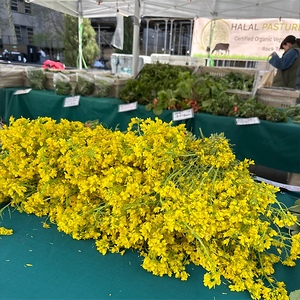


Green Mizuna Flowers
Estimated Inventory, bunch : 0
This item was last sold on : 04/03/24
Description/Taste
Green Mizuna flowers are small and bright yellow, measuring approximately one centimeter in diameter, and appear along the ends of thin and delicate stems featuring bright green deeply serrated leaves. The flowers are comprised of four elongated oval petals arranged symmetrically around four stamens and may contain a mixture of tightly closed buds and open flowers when harvested. Green Mizuna flowers have a spicy and honeyed aroma, and the flavor is peppery and piquant with a mildly bitter-sweet finish.
Seasons/Availability
Green Mizuna flowers are available beginning in early spring, and the season may continue through the end of the summer.
Current Facts
Green Mizuna flowers bloom from mizuna, a green leafy vegetable in the mustard family, botanically classified as Brassica rapa var nipposinica. Other common names for the delicate greens include Kyona, Japanese mustard, Shui Cai, and California peppergrass. Mizuna is a hybrid of arugula and mustard greens that is also related to broccoli, cauliflower, kale, and Brussels sprouts. The delicate and peppery vegetable is a staple throughout Asia, highly prized for its long growing season. The greens are easy to cultivate and can be grown year-round, even in colder temperatures. Named for the Japanese word for water, "mizu," the greens require very moist soil to grow. If the plants get too dry or stressed, they will bolt and develop small, bright yellow flowers. At this point, the greens may become bitter, but the flowers can be harvested and enjoyed in similar applications as the greens. In Japan, mizuna is classified as a Kyo Yasai vegetable, which refers to heirloom vegetables traditionally grown in Kyoto. The greens are an important cultural ingredient in Japan, enjoyed in ozoni, a dish eaten during the Japanese New Year that is consumed for good luck. Green Mizuna flowers can be harvested when young and enjoyed along with the greens and stems of the plant during the summer months or removed from the stems and used on their own.
Nutritional Value
Green Mizuna flowers are a significant source of antioxidants, such as quercetin, beta-carotene, and kaempferol. These compounds are known to aid in the reduction of inflammation as well as support heart and eye health. The greens contain a high level of vitamin K for bone health and blood clotting and vitamins A and C for immune support. Mizuna also contains essential minerals such as calcium, magnesium, iron, and selenium.
Applications
Green Mizuna flowers have a sweet, vegetal, and piquant flavor suited for fresh and cooked preparations. The flowers are traditionally used when they are just emerging from the buds and are treated like an edible garnish, added at the end of the cooking process to prevent wilting. The entire stalk can be used, or the flowers can be separated from the greens and sprinkled over salads, stirred into pasta, used as a garnish over appetizers, lightly pressed into soft cheeses, or folded into dips. The blossoms can also be floated over soups, incorporated into fresh spring rolls, mixed into stir-fries, noodle dishes, and rice, or placed on top of sushi and other seafood dishes. The flowers are sometimes baked into casseroles, quiches, and macaroni and cheese, or they can be used in various pickled preparations. The flowers and greens are traditional ingredients in Japanese hot pot. Green Mizuna flowers pair well with herbs such as parsley, basil, lemongrass, and mint, spices such as cumin, fennel, and coriander, and citrus, especially tangerine, grapefruit, and lime. The delicate blooms should be immediately consumed for the best quality and flavor and will only keep for 1 to 2 days when stored in a container in the refrigerator.
Ethnic/Cultural Info
In Kyoto, Japan, mizuna is a protected heirloom vegetable. Known as Kyo Yasai, the protected designation is given to vegetables grown before the Meiji period of the 1800s that have cultural significance in the country. Kyoto was the imperial capital of Japan from 794 BCE to 1868 BCE. During that time, people came from all over the country to present offerings to the city’s shrines and temples as well as to the emperor himself. These offerings included textiles, jewels, animals, and vegetables. The favorites of these vegetables were cultivated in Kyoto and refined through breed selection. Mizuna was planted around temples in Kyoto, where natural springs kept the soil wet enough for the plants to flourish. Kyo Yasai vegetables have rich histories that the Japanese government is determined to maintain with this protection. The vegetables are well known for their bright colors, shapes, scents, and flavors which are considered superior to commercially cultivated varieties. Kyo Yasai was rebranded in 1989 and is now promoted as ‘Kyoto Brand Products’. Each package is labeled with a stylized red capital K in a golden circle and bears the prefix ‘Kyo’ to denote their superior quality, rich history, and connection to the old Imperial capital city of Kyoto.
Geography/History
Mizuna is believed to be native to China but is most popularly used in Japan. The vegetable has been grown in Japan since antiquity in the Kansai region, mainly in the city of Kyoto. Historically, the vegetable was cultivated around the Mira-Dera temple in the south of the region. Mizuna was introduced to France in 1845, but the ingredient was poorly received, and the entire plant family was lost. Seeds were re-introduced to Europe later in the century and grown in small quantities. The greens grew in popularity in Europe and the United States during the late 20th century due to demands for interesting and nutritious ingredients as well as the popularity of Asian cuisine in Western countries. Mizuna grows easily year-round in cold and temperate climates. The plants require moist soil to thrive and will bolt if the soil is too dry. Green Mizuna flowers can be found during the spring and summer months in these regions at farmers markets, farm stands, and specialty stores.








